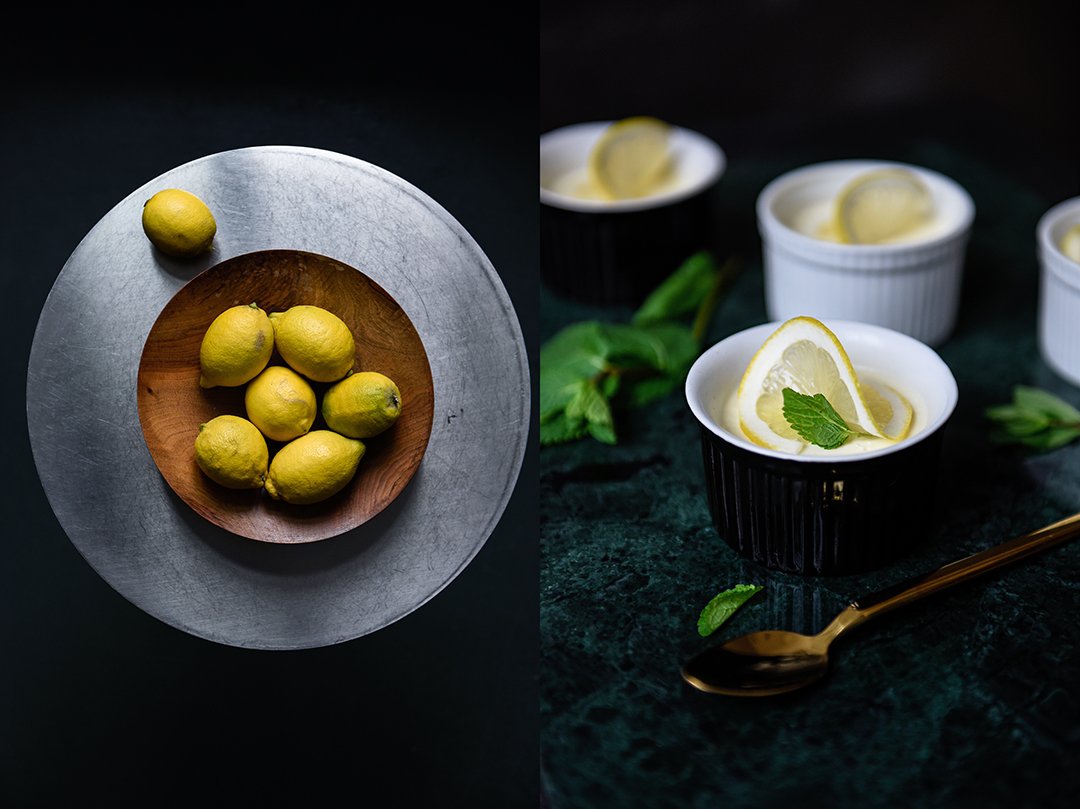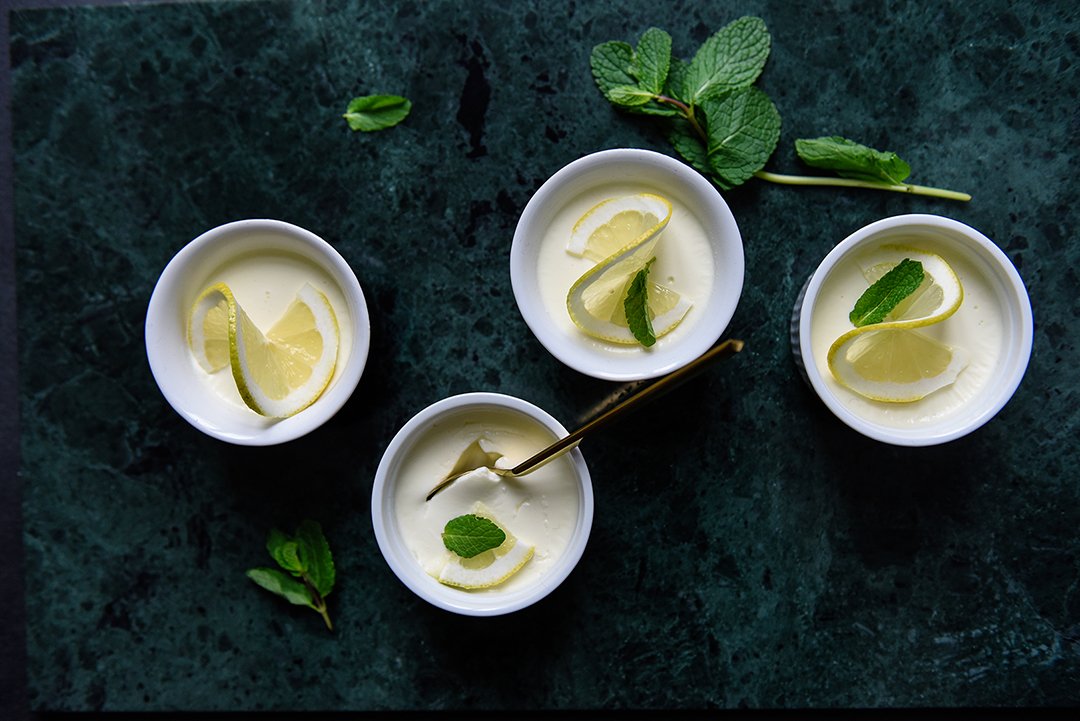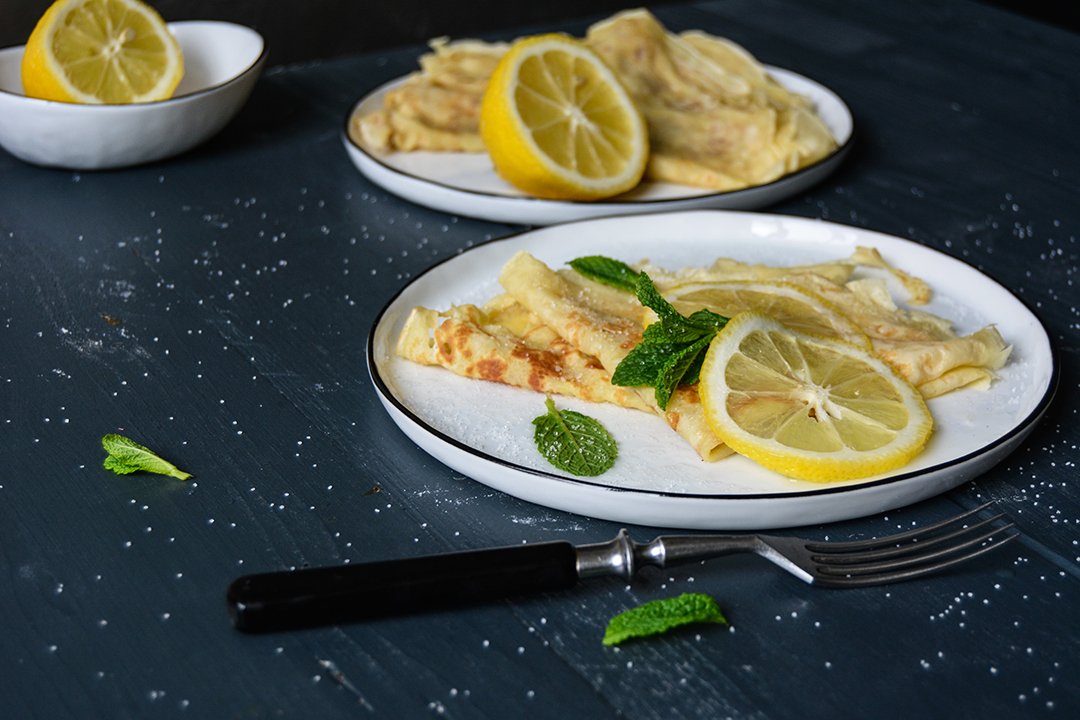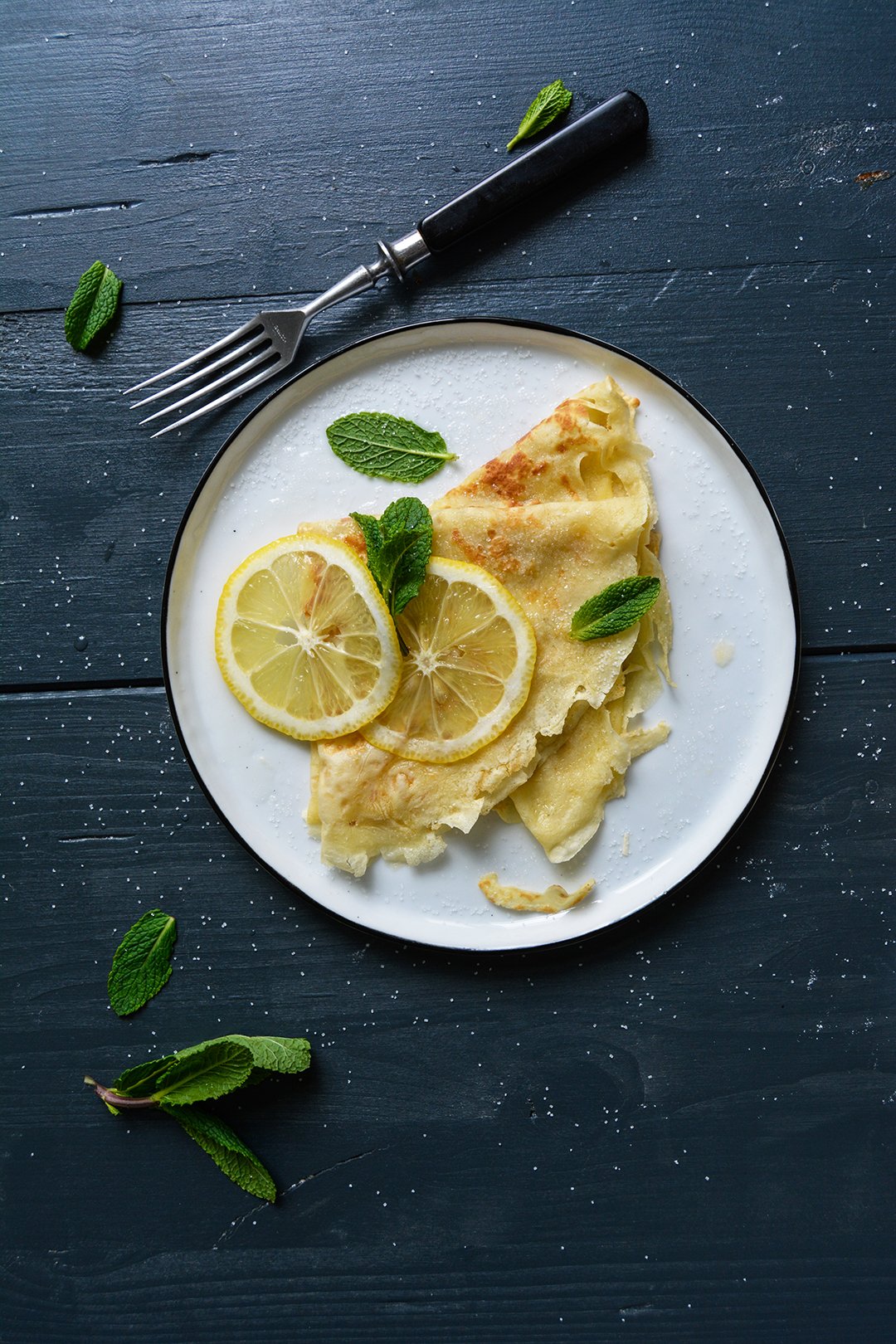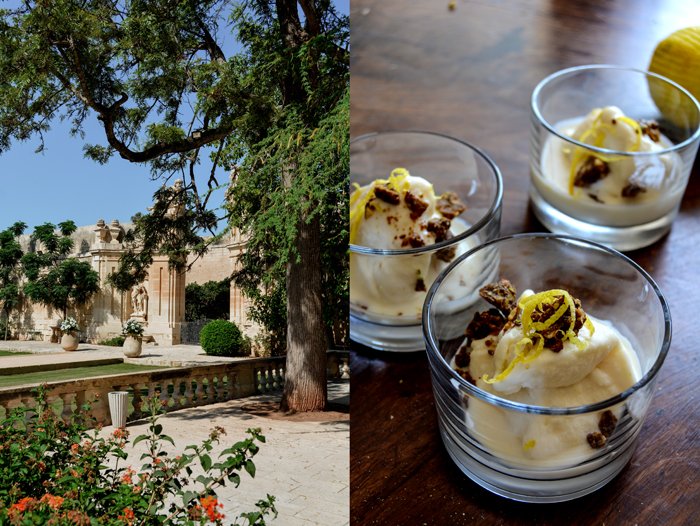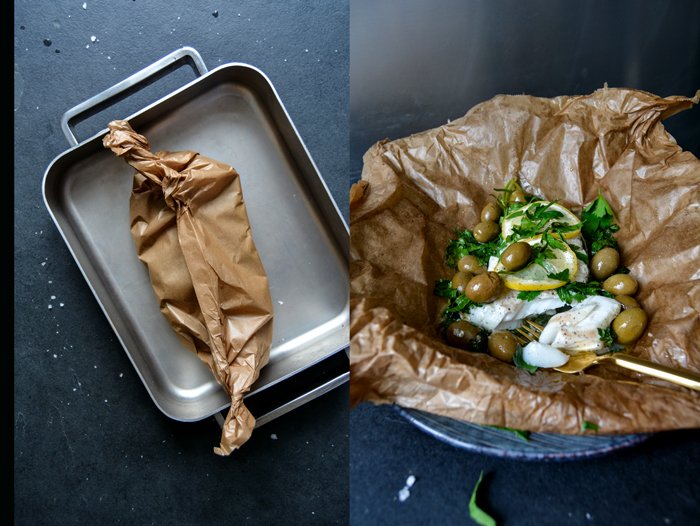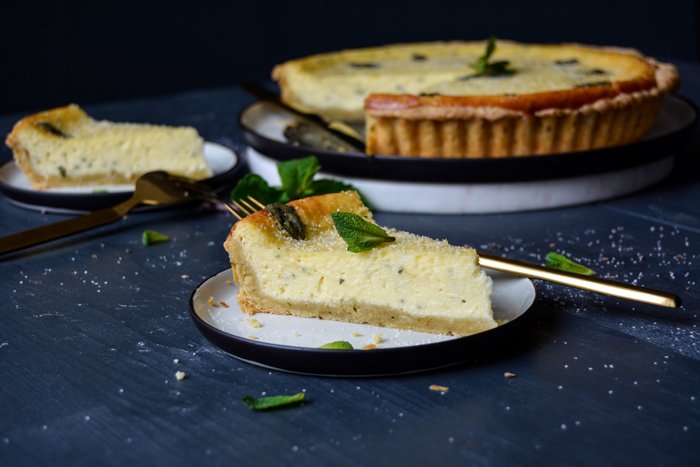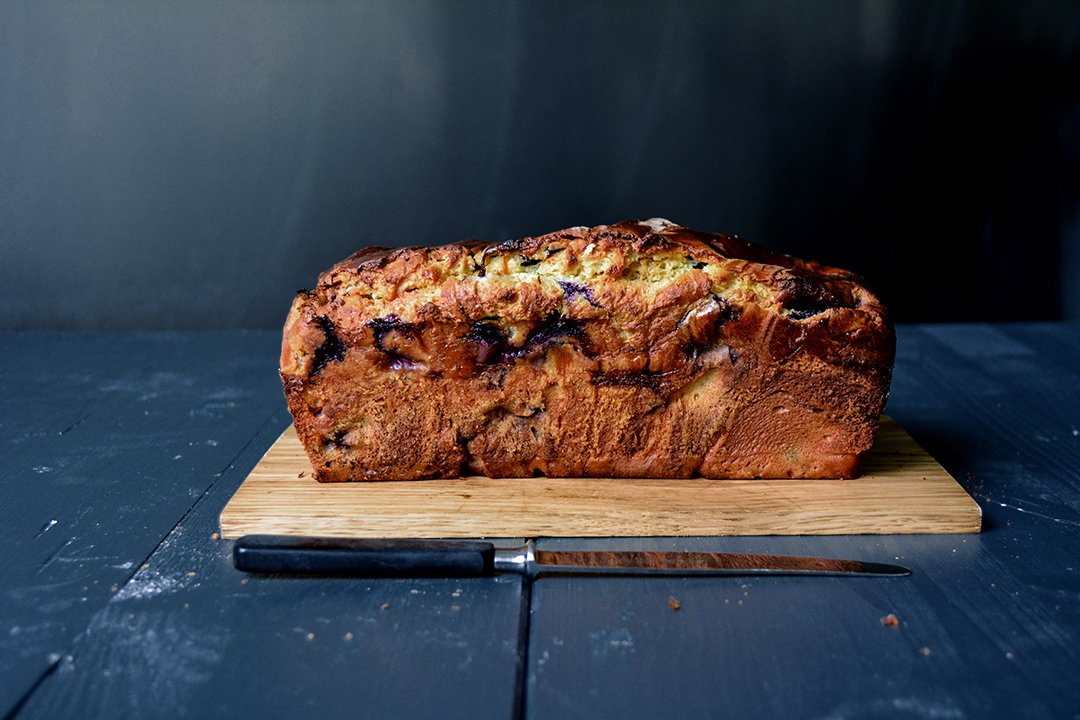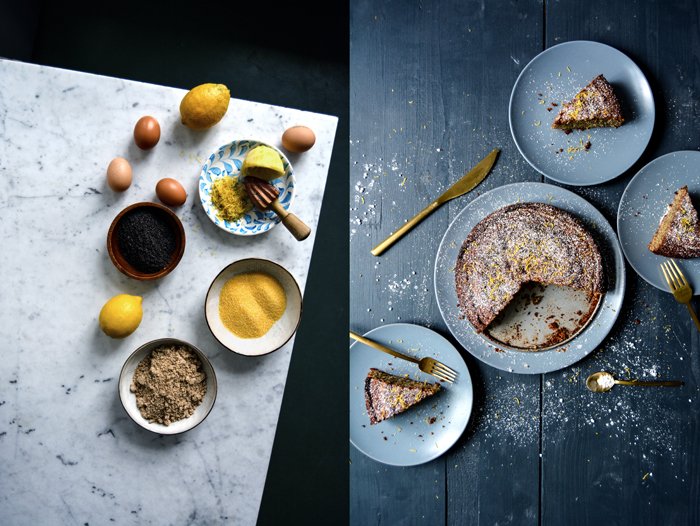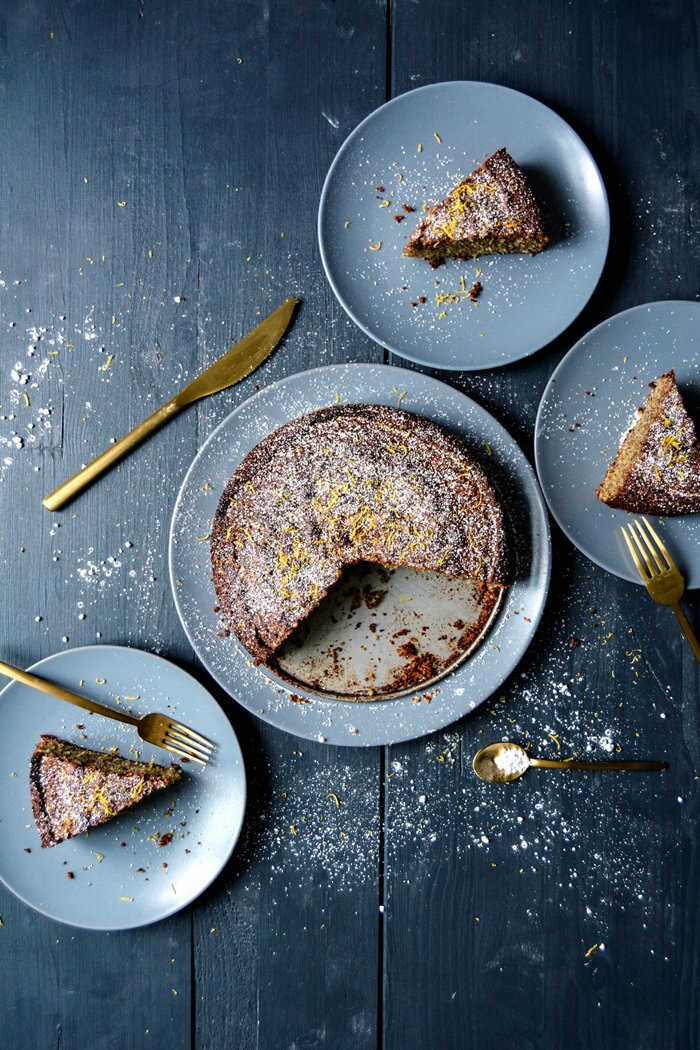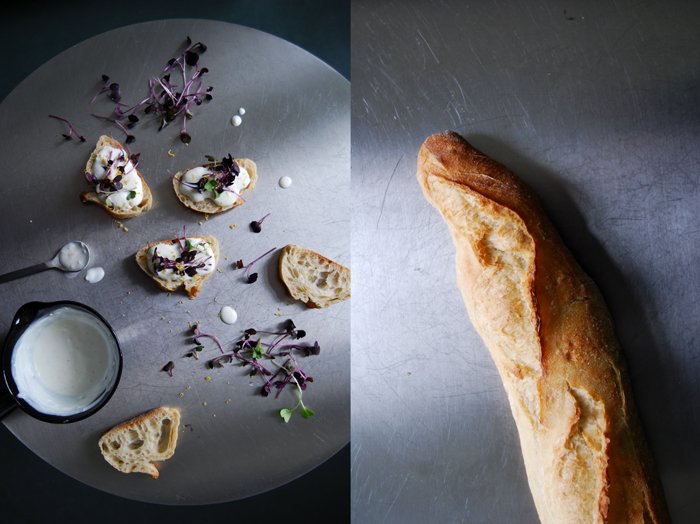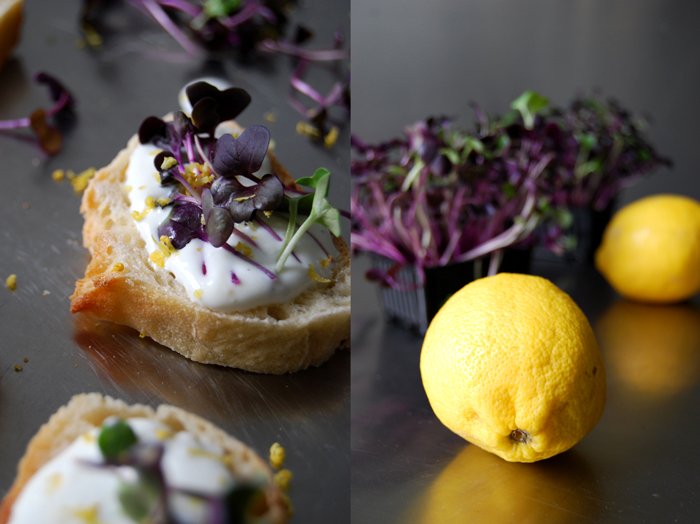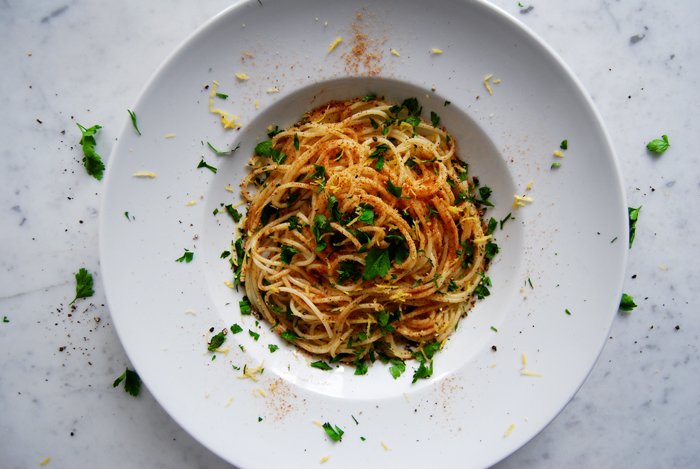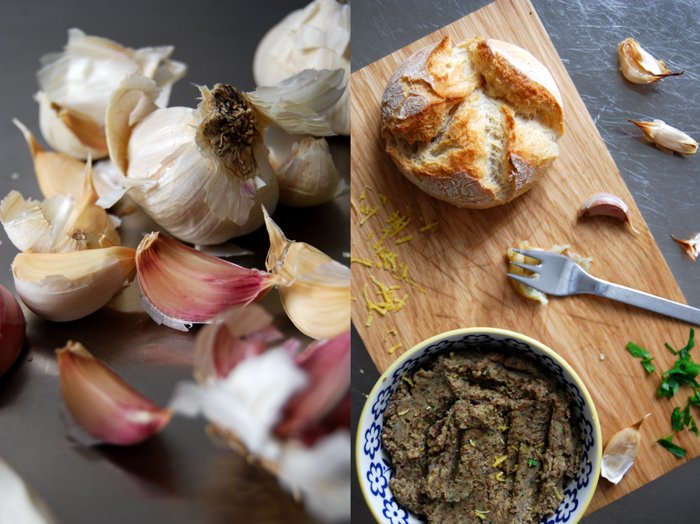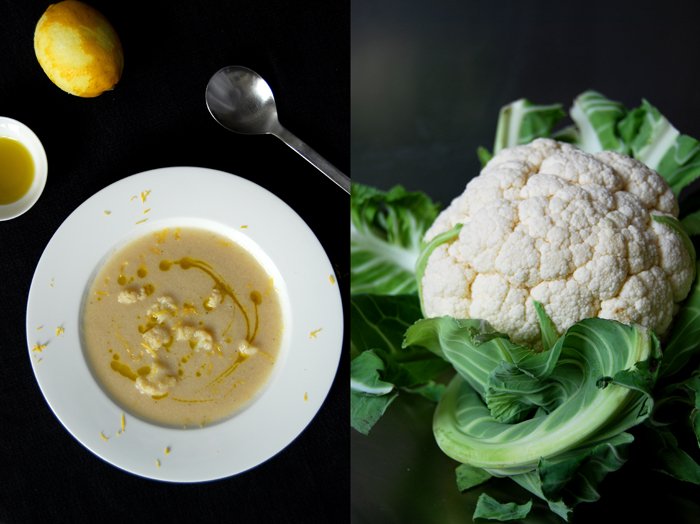Limoncello Panna Cotta
Some years have the pace and mood of a little stream in the woods, burbling along quietly, without anyone really taking any notice of it. And then there are years that are more like a hungry wave, rolling like thunder and hitting the shore with a crash, ready to pull you off your feet and make you tumble in the most unexpected moments. 2017 had quite a few of these moments, whirling and twirling, they shook the world politically, socially, and environmentally, and also my own world on so many levels. It's exhausting when the ups and downs wear out the mind and squeeze it like a sponge, but it's also a challenge that forces us to question and grow in our own existence and that's its gift. I believe that our human mind needs to leave the known path once in a while, our comfort zone, that can easily become too comfortable and that makes us lazy. The irritating state of mess and confusion can be a great starting point to be brave and dive into the unknown, as much as I hate these moments as it's scary, I'm thankful, afterwards, when they force me to unfold the old, familiar pleats.
Just over 12 months ago, the Eat In My Kitchen book was sent out into the world and little did I know how much it would change my life and the way it used to be. In April 2017, Andrew Zimmern hung the medal for the James Beard Award for Best Cookbook in the General Cooking category around my neck, the state of bursting happiness, surprise, and thankfulness that I felt on that magical night in New York lasts until today. The world also revealed some of its culinary tricks and secrets to me as I travelled in America, Asia, and Europe during autumn. I was on the road for a new project and, for once, I let other people cook for me. I was introduced to the wonders of food in some parts of the world where I had never been before. It was pure bliss to experience new tastes and smells, to listen to unknown languages and learn about traditions and rituals that grew over centuries. And to see so many inspiring women in their kitchens, wherever I was, women who strongly believe in a gastronomic concept of respect and togetherness, women who create praised and highly celebrated restaurants, that made me happy and confident that the future will bring more and more of these fantastic female chefs into the spotlight.
In 2017, we all lost and gained, we gave and took, and as long as the exchange feels balanced, it was a good year. Before I pull the plug and go offline for a week, finally after 4 years of constant buzzing, I have one more thing to give to you: the recipe for this joy-bringing limoncello panna cotta. Now you have a sweet recipe at hand, for the moments when life gives you lemons.Enjoy food, wine, and especially time with the ones you love, have a happy Christmas and a joyful start to an exciting 2018!
Meike xxx
Limoncello Panna Cotta
Serves 2 to 4
gelatin sheets 2 1/2 (7 x 11-cm / 3 x 4-inch)
heavy cream 240 ml / 1 cup
whole milk 120 ml / 1/2 cup
Limoncello 60ml / 1/4 cup
lemon peel 2 long strips
granulated sugar 2 tablespoons
fine sea salt 1/8 teaspoon
lemon slices, very thinly cut for decoration (optional)
fresh mint leaves for decoration (optional)
Soak the gelatin sheets in cold water for about 5 minutes.
In a small saucepan, bring the cream, milk, Limoncello, lemon peel, sugar, and salt to the boil. As soon as the mixture is bubbling, take the pan off the heat. Squeeze the excess water from the soaked gelatin sheets, crumble into the warm cream mixture, and whisk thoroughly. Let the mixture cool in the pan, whisking occasionally.
Once the cream mixture is at room temperature—it will still be liquid—divide it between 4 120-ml /4-ounce ramekins. Cover them with plastic wrap and refrigerate for 1 hour. Transfer the ramekins to the freezer and chill for about 35-45 minutes or until set but not frozen. Alternatively, leave the ramekins in the refrigerator for about 3 hours or overnight.
Decorate the panna cotta with lemon slices and mint just before serving.
Langostini al Cartoccio cooked in seawater
Malta, August 2017:
I'm sure I spent more time in the water than on land in the past few weeks. When I'm in Malta, I turn into a fish, I practically live in and from the sea. Crystal blue water, secluded bays, and hidden caves under limestone arches are my very own little Mediterranean paradise. And once I'm out of the water, there's often the freshest seafood on my plate. Simplicity rules Malta's summer cuisine, a whole fish or pink crustaceans from the grill seasoned with a squeeze of lemon and some parsley from the fields, tender octopus in an aromatic stew - great quality ingredients don't need much to shine.
Although I enjoy visiting the islands' villages on Malta and Gozo a lot, walking down the quiet alleys and stopping for a cappuccino or ice cream at one of the old cafés, if there's a chance to put my goggles on and snorkel, you can be sure to find me in the water within a split second. In the first week, I went to my beloved Fomm ir-Riħ to sadly find the gravel beach considerably narrowed by clay swept down from the steep hill behind it. The sea was rough, so I didn't even bother walking down the hidden track along the cliff face. I went to Sliema's city beach instead and finished the day with my obligatory sun-downer - a glass of Ricard at the Exiles bar. Sitting on the warm rocks and smelling the salty air - after a dip in the sea of course - is one of the best ways to end a day in the Mediterranean.
Another trip took me to Marsaskala, a seaside village that I never really gave the attention it deserves. It's a very Maltese place, not many tourists, old houses, bars, and palm trees lined up along the promenade where the young and old meet after sunset. I had a Ftira sandwich for dinner, but before I dove into village life I discovered a beautiful rocky beach north of the Xrobb l-Għaġin Temple. It was so peaceful, the endless sea framed by chalk-white cliffs softly sliding into the water.
On one of my trips to Gozo, I discovered a recipe that I'd love to share with you today. Noel, the excellent chef at his open-air restaurant at the deep Mgarr ix-Xini bay - which is a bit tough to find - cooked the sweetest langostini al cartoccio in seawater. He doesn't have to go far, a few steps from his place he finds the cleanest Gozitan sea, always at hand to cook seafood in his preferred method: wrapped in a package, al cartoccio, with a splash of seawater, on the grill. Don't worry if you don't happen to live at the sea, just use normal water mixed with the best sea salt you can find, that's what I do at home. I got Maltese langostini, which are the sweetest I know. Noel's crustaceans were a little smaller than mine and tastier, however, my fish monger only had the larger size. You just have to add some lemon wedges to the package and cook it on the grill for a few minutes (or in the oven). They cooked to perfection, with a gentle touch of the salted water. I used Gozitan salt, which I find not only subtle in saltiness, but also tastier than any other I've tried. Choose a good one, it's worth it!
Seawater cooked Langostini al Cartoccio from the Grill
You can cook the langostini on the grill or in the oven.
Serves 2
extra wide aluminium foil
medium langostini, fresh and uncooked, 8-10
sea salt 1 tablespoon
water, warm, 300ml / 1 1/4 cups
olive oil
organic lemon, cut into wedges, 1
Start the grill or preheat the oven to 200°C / 400°F (conventional setting).
Lay 2 pieces of aluminium foil on top of each other, large enough to wrap the langostini.
Stir the salt into the warm water and let it sit until the salt dissolves. Or, if you happen to live close to the clean sea, use the same amount of fresh seawater.
Lay the langostini in the middle of the aluminium foil and fold up the sides. Add the salted water / seawater, a generous splash of olive oil, and the lemon wedges. Wrap the package and seal the ends well.
Cook the langostini for about 3-5 minutes on the grill (I closed the lid of the grill), or in the oven, until they are just done.
Serve immediately with fresh bread and, if you like, a glass of chilled white wine.
Crêpes au Citron
Rough seas, endless beaches, and food that kept me happy from morning till midnight. I went to France and it was a feast.
I got spoiled with a spontaneous trip to Normandy together with my mother, to the picturesque seaside village of Le Touquet. Five nights, five days and luckily, I didn't have much time to make plans beforehand - or to build up expectations. This kept me relaxed and the activities very basic: I went from my bed to the opulent breakfast table, then straight to the beach for long walks, a quick snack on the 'high street' before teatime or an aperitif at our hotel's beautiful old-fashioned bar; at 7pm I was dressed pretty and ready for the French way of dining - luscious feasting that makes you forget about everything around you and lets you sleep like a baby. Those were my days in Normandy.
We couldn't have organized our arrival at the majestic Le Westminster any better. We were hungry and stepped out of the car just in time for lunch. The hotel's bistro offered a French classic, Steak Tartare, and a fantastic dish of potatoes, cut thinly and cooked like risotto, with smoked eel and truffles. A glass of Sancerre and our French immediately came out more fluently. It was the beginning of a culinary trip that couldn't have satisfied my taste buds any better: the freshest oysters, lobster, large rock crab, prawns, and sea snails, Breton Cotriade (fish soup with potatoes) topped with half a lobster (preferable enjoyed at Perard on Rue de Metz), Moules Frites, oeufs a la neige (floating island), and wonderful salads, all very simple combinations with only a few ingredients, but the results were superb.
During our first walk through the village I spotted a fantastic pâtisserie. My instinct is very reliable when it comes to sweets, I can 'smell' where I can find the best éclair au café, croissants, little tartes Tropéziennes, brioche and baguette. The bakery's staff saw me daily. The farmers' market on Saturday is a weekly celebration in the village, fruits and vegetables, salamis and patés, the most fragrant (and pungent) cheeses, the fishermen's catch from the night, honey and jam, all laid out in front of us. We were like kids in a candy store and bought bags full of delicacies, which we then stored in the car for a couple days to take back home with us. It was quite cold outside so it didn't harm the food. However, the cheese infused the car with such a distinct aroma that I'm sure we'll enjoy it for months.
As much as I love a glass of Champagne and a plate full of Atlantic oysters sprinkled with mignonette (chopped shallots in vinegar), the simple pleasures are sometimes the best in life. Le Touquet has an excellent Crêperie, Aux Mignardises Saint Jean, where you can watch the masters of crêpe cook such delicious creations as crêpe au caramel or au citron (both tested and approved). The simple yet so genius addition of a good squeeze of lemon juice really hit me. It was totally new to me, how could I have missed it? You just have to cook a thin crêpe, sprinkle it with a little sugar, and drizzle it with the sour juices of the citrus fruit. First I started with a few drops, but then I learned that you should be generous, the more lemon, the better! Back home, I already made it twice and here's the recipe for you. If you feel like a quick, but scrumptious breakfast or lunch, or if you'd like to impress your guests at your next dinner party, flip some crêpes in the pan and buy a bunch of lemons.
Another treat, a savoury buckwheat galette, was just as good and included ham, cheese, and an egg. It was actually so good that I might also share this recipe with you in the near future.
And if you're not into citrus, try one of these recipes:
Crêpes au Citron
Makes about 15-20 crêpes
plain flour, sifted, 260g / 2 cups
granulated sugar 50g / 1/4 cup, plus more to sprinkle the crêpes
fine sea salt 1/8 teaspoon
organic eggs 4
milk 1/2l / 2 cups and 2 tablespoons
butter, to cook the crêpes
fresh lemons, cut in half, about 2-3
fresh mint leaves, a small handful (optional)
In a large bowl of a stand mixer fitted with a whisk, mix the flour, sugar, salt, eggs, and milk until smooth; let the batter sit for about 10 minutes (at room temperature) to 1 hour (in the fridge).
In a large, heavy or non-stick pan, melt half a teaspoon of butter on medium-high heat. Pour in a ladle of the dough, holding the pan in your hand and turning it so that the dough spreads evenly and very thinly. The crêpes won’t need more than 30-60 seconds on each side once the heat is set right. When the crêpe is slightly golden on both sides, sprinkle with a little (!) sugar, fold twice so that it forms a triangle, and transfer to a large plate. Cover with a large plate or lid. Continue with the remaining batter until you have about 15-20 crêpes. You should always melt 1/2 -1 teaspoon of butter in the pan before you cook the next crêpe.
Serve the crêpes warm, sprinkled with additional sugar to taste, drizzled with freshly squeezed lemon juice (to taste), and decorate with a few mint leaves. Bon appétit!
Spaghetti with Lemon Pistachio Pesto and Mozzarella di Bufala
I love to end the year with a plate full of spaghetti. It gives me the kind of comfort that pasta masters to perfection. Its beauty and magic lies in simplicity - and in many happy carbs. This year's combination is tangy, a bit creamy, and nutty - it makes me feel good and that's all I need. So here's my Mediterranean creation to celebrate the changeover from 2016 to 2017: spaghetti with lemon pistachio pesto and mozzarella di Bufala.
In the past 12 months of this turbulent year I felt my limits quite often and I flew higher than I thought I could ever fly without burning my wings. I saw my first cookbook being born, being celebrated during my book tour in Berlin, London, Malta, New York, and Washington. I saw the Eat In My Kitchen book reaching the New York Times' list of 'The Best Cookbooks of Fall 2016', which I still can't really believe. So much love and support came into my life, so much happiness has been spread through this book that feels like a baby to me. There were unbelievable highs, so many wonderful moments, moments that I will feel thankful for for the rest of my life. But there were also lows and losses that tore trenches into my heart that will hurt for the rest of my life. I lost a person who's been so close to me that I sometimes can't even say who's me and who's him. He was my mentor, my supporter, my biggest critic, my challenger. He was my friend, my most beloved Swabian, and my step father. I wouldn't be who I am without him, and I'll never again be who I was before he left this world. Eat In My Kitchen wouldn't be what it is without him.
I want to thank all of you for supporting me and my book, for being there and for coming back to these pages here on the blog. Eat In My Kitchen makes me grow every day, this blog makes me go back to my kitchen and experiment more than I would do if I didn't write about it. Thank you for being on this journey together with me.
Have a peaceful and joyful start to the New Year!
Meike
Spaghetti with Lemon Pistachio Pesto and Mozzarella di Bufala
Serves 2
For the spaghetti
dried spaghetti 200g / 7 ounces
olive oil
mozzarella di Bufala, torn into bite sized pieces, 125g / 4 1/2 ounces
flaky sea salt
black peppercorns, crushed in a mortar
For the pesto
freshly grated lemon zest 4 tablespoons, plus more for the topping
freshly grated young Parmesan 4 tablespoons, plus more for the topping
finely chopped shelled pistachios (unsalted) about 1 tablespoon, plus more (roughly chopped) for the topping
olive oil 3 tablespoons
fine sea salt
In a large pot filled with salted water, cook the pasta until al dente. Drain and stir in a little splash of olive oil.
For the pesto, in a medium bowl, whisk together the lemon zest, Parmesan, pistachios, and olive oil and use the back of a spoon to press the Parmesan into the oil until well combined. Season to taste with salt.
Divide the spaghetti and mozzarella di Bufala between plates. Sprinkle with pesto, additional lemon zest, Parmesan, and pistachios. Season to taste with flaky sea salt and crushed peppercorns, serve immediately.
Marina's Lemon Marmalade Ice Cream with Caramelized Pistachios
A month has passed and I have to leave my beloved archipelago in the deep blue Mediterranean Sea behind. This is the last recipe from my Maltese summer, but I'll be back soon, in October, to present my 'baby' at one of my book launch events, at the fabulous Villa Bologna in Attard.
It's been a summer full of emotions, with lots of work during the day and family gatherings or evening swims afterwards - the fun began as soon I closed my laptop and put my phone aside. I've been busy organizing the book launches in Europe and the US, I survived my first interviews and photo shoots and I met so many wonderful people who'll be helping me over the next few months. To my surprise, I've been enjoying everything that comes along with being a cookbook author. I love giving interviews (I love talking!) and I've been quite lucky, I've only met very interesting and entertaining people to talk to so far. Photo shoots are still a bit challenging for me, I prefer to stay behind the camera. Usually, I ask my man to accompany me, he manages to make me laugh in the weirdest situations - the result is that we have lots of photos with a big smile on my face. We had a fun shoot with my friend, the great photographer Luke Engerer in Malta. He put me on the roof terrace of his house, the sea in front of me, sparkling in the light of the sinking sun. It was so amazing that I didn't even mind getting naked on the roof to change (I just hope that none of the neighbours had a camera at hand).
The problem with such a busy schedule is that time flies even quicker. It feels like we just arrived, on that hot night in July and now it's already mid August and I'm sitting at our dining table, back home in Berlin. For some reason, my home city must have misunderstood the season, Berlin welcomed us with autumn weather, I had to pull out the wool pullovers from the far back of my wardrobe. To ease the pain, I keep looking at the hundreds of pictures I took during the past 4 weeks and I remember every single second that I see in the pictures. I can smell the salty air, I can feel the hot wind on my skin, and I can even taste the ice cream that Marina made for us when we met in the kitchen and gardens of Villa Bologna. It was very lemony and it tasted so good - it was also the first recipe Marina ever made for me, back in the summer of 2015. This recipe is genius, it's only made with lemon marmalade, heavy cream, milk, and the juice and zest of a Maltese lemon. We were so impatient, that she took it out of the ice cream machine as soon as the motor stopped. It was an early afternoon and so hot, that the ice cream started to melt as soon as we scooped it into the glasses. Marina topped it with caramelized pistachios and lemon zest and I can't think of a better ice cream for summer - it was divine!
Whenever I have to exchange my Malta life for my Berlin life again, I tend to get a little stressed during our last two days on the islands. There's a lot of packing to do, but this time we had to sort out the transportation of 33 pounds (!) of sea salt from Mr Cini's salt pans in Gozo - and we managed. I also had to put away numerous packages of ottijiet cookies from Busy Bee and there were many fragile shells collected from the bottom of the sea waiting to be brought to Berlin to find a place on our window sills. Although they are already covered in shells, I can't stop collecting more and more of them. When the packing is done, we have a long goodbye ceremony with the family at our granny Edith's house, accompanied by a few tears and food. And when we've waved the last goodbyes and I've finally gone through security at the airport, I usually feel exhausted. I just want to get on the plane and relax, which always works out perfectly, thanks to the country's national airline, Air Malta. I love their cute looking planes, their friendly staff, and the fact that I don't have to worry about the weight of my luggage. Everyone gets 20kg (44 pounds) for free, just like in the good old days of flying.
Thank you Malta for another amazing summer! xx
And my last tip for the islands: I found a new old bakery in Rabat, they work traditionally and their baked goods are to die for!
Lemon Marmalade Ice Cream with Caramelized Pistachios
Makes about 1.5l / 6 cups of ice cream
heavy cream 500ml / 2 cups plus 2 tablespoons
milk 500ml / 2 cups plus 2 tablespoons
lemon marmalade 200ml / 3/4 cup plus 2 tablespoons
juice and zest of 1 lemon
For the topping
granulated sugar 100g / 1/2 cup
pistachios (or almonds), roughly chopped, 50g / 2 ounces
freshly grated lemon zest
For the ice cream, chill all the ingredients and churn in an ice cream machine until creamy. If it's still too soft, keep it in the freezer until completely frozen.
For the topping, add the sugar and pistachios to a frying pan and stir over low heat with a wooden spoon until melted. Quickly transfer the caramelized pistachios to a baking sheet and break into pieces when cool.
Divide the ice cream between bowls and sprinkle with caramelized pistachios and freshly grated lemon zest.
Cod al Cartoccio with Olives, Parsley and Lemon
Whenever I cook fish al cartoccio and I enjoy the tasty fillet's firm perfection, I ask myself, why should I ever cook cod, salmon, trout, or monkfish any other way? If the timing and seasoning is right, the texture will be flaky and the meat infused with whatever aromas you decide to add to the paper bag. Fresh herbs, warming spices, fresh or preserved lemon, olives, capers, thinly sliced vegetables or prosciutto even, there are endless possibilities to turn dinner into an exciting package of flavours. However, when I'm in my Maltese mama Jenny's garden in Msida, I feel the same about barbecued fish: Why should I ever turn on the oven again when there's a nice catch from the fisherman on the table?
When we set up our BBQ in Berlin, there's mainly meat and vegetables on the roast, fresh fish is a rather rare occasion, it stays in my indoor kitchen most of the time. In the city, I never plan my seafood meals, I buy what looks fresh and yummy and then I decide what's going to happen with it. My thick piece of cod from the Atlantic got wrapped in a package, but before I closed it, I added lots of fresh parsley, green olives, white wine, and lemon slices. It was a beautiful Mediterranean lunch, which you should enjoy on a Saturday or Sunday, when there's no more work waiting for you and you can pull a bottle of crisp white wine out of the fridge (without feeling guilty). Just relax and break chunks off an oily loaf of ciabatta to dip into the juices - summer perfection!
Cod al Cartoccio with Olives, Parsley and Lemon
Serves 2 for lunch
olive oil
cod fillet (or any firm, white fish, such as monkfish or halibut), preferably a thick center piece, about 350-400g / 12-14 ounces
fresh flat-leaf parsley 1 medium bunch
green olives, with pits, 14
organic lemon, rinsed and scrubbed, 2 slices
white wine 2 tablespoons
freshly squeezed lemon juice 1 tablespoon
fine sea salt
ground pepper
Set the oven to 200°C / 400°F (convection setting).
Cut 2 pieces of parchment paper large enough to wrap the fish and lay them on top of each other. Brush the top sheet with olive oil, place all but 1 sprig of the parsley in the middle, and lay the cod on top. Season to taste with salt and pepper. Put the remaining parsley on top of the fillet and finish it off with the lemon slices. Arrange the olives around the fish. Whisk the wine with 2 tablespoons of olive oil and the lemon juice and pour over the fish. To close the package, fold the sides over, twist both ends of the parchment paper, and fold the top twice so it’s well sealed. Place the parchment package in a baking dish and bake for 10 minutes. If you can flake the fish gently with a fork, it’s done. If not, close the parchment again and continue baking for up to 5 minutes. The cooking time can vary depending on the fillet's thickness, but mind that you don’t overcook it.
Cynthia Barcomi's Cheesecake with Mint and Aniseed Crust
This recipe comes from a woman who is a great inspiration in the kitchen and for life - and she's also one of the reasons why I live where I live. I used to visit Berlin quite often in my twenties and on one of those trips, I discovered Barcomi's Deli right in the heart of the city's old Eastern part. The moment I walked through the hidden Sophienhöfe for the first time, I fell in love with its peaceful backyards and the tall brick walls covered in vine. When I opened the glass door to Cynthia Barcomi's cozy café, I found my place (update: sadly, the café closed in 2021). Amazing coffee and the best American cakes, muffins, and sandwiches I had ever tasted, I was hooked. So I decided that if I ever moved to this city, it would have to be close to Cynthia's kitchen. And that's what I did.
Cynthia is from New York. In the late 80's, she came to Berlin to live and work here as a professional dancer. Today, she's one of Germany's most successful women in the food business. She started roasting her own coffee beans long before it became a trend, and she introduced the people in her new home city to all the scrumptious treats she grew up with: bagels, New York cheesecake, fruit pies, and luscious sandwiches made with the juiciest potato bread. It became a great success. When you meet Cynthia, you can see right away that she's not the kind of person who would rest if something works out. She's constantly on the move, her enthusiasm is impressive, and she jumps from one project to the next project. She started a flourishing catering business, became a popular TV host, sells her own bakeware collection (she has the most perfect pie dishes!), and she wrote six best selling cookbooks. And all this as a mother of four children - sometimes I wish I had her energy.
It's only a year ago since Cynthia published her last book Cookies, which includes the best brownie recipe I know: chocolate and peanut butter. They are divine. Her new masterpiece is just as packed with deliciousness and focuses on Cheesecakes, Pies & Tartes (in German). It's a very special book, as Cynthia, for the first time, shared her signature cake, the best New York cheesecake in town. Her fans have been bugging her for years to share it with them, but she declined. So finally, after 20 years, she had mercy on us and opens her new book with this exact recipe. When I decided to write about Cynthia's new creations, I felt so tempted to bake this cake and share the recipe here with you, but I wasn't even sure if I feel quite ready to bake this cake at home in my kitchen. I've ben enjoying it for so long at her café, do I want to know how this piece of magic is actually made? I think for now, I want to leave it this way, I just jump on my bike whenever my appetite calls for it and roll down the hill to her Deli.
But as I thumbed through the pages of her new book, reading about such tempting treats as Blueberry Pocket Pies, Peanut Butter Townie, Sweet Potato Spice Bars with Potato Chip Crust, and Honey Almond Goat Cheese Cheesecake, I got excited. And then I spotted a recipe that made it impossible to read any further: A Spanish Cheesecake or Flaó from Ibiza. The pie is made with ricotta and mascarpone and refined with lemon and mint - this is genius! The filling lies on an aniseed short crust base and it's the most aromatic, fragrant, and light cheesecake I ever had on a plate. Two days ago, I shared the last pieces of it with some friends and there was happy silence at the table. I never even thought of adding mint to a cheesecake and it's actually the best thing that could happen to it. Cynthia learned about this combination from a friend's aunt, Maria, an eccentric art collector from Spain, living in New York. I have to start thinking about what else I could do with the mint plant outside my kitchen window.
When I sipped on my creamy cappuccino at Barcomi's many, many years ago, it would have never crossed my mind that one day, the woman who created all this would become more than an inspiration in my life. Cynthia gave me the best tips for my book when I started working on it. She shared her experiences with me and helped me so much during the whole process in the past year. And then, when I asked her if she'd like to write a quote for my book, she didn't hesitate. I emailed her the pages of the Eat In My Kitchen book, and I have to confess that I felt a bit nervous to share it with her. When I read her words, it brought me to tears:
"Great food like great art speaks the truth. Meike’s recipes and photos are pared down, honest and revealing – I love what she does! She goes right for the sensory jugular leaving you wanting and needing more. Void of superfluous detail, Meike’s all about delicious food – brava!"
Thank you Cynthia!
Cynthia Barcomi's Mint Cheesecake with Aniseed Crust
Serves 6
For the pastry base
plain flour 200g / 1 1/2 cups
granulated sugar 2 teaspoons
aniseed, finely crushed in a mortar, 1 1/2 teaspoons
salt 1/2 teaspoon
freshly grated zest from 1/2 lemon
unsalted butter, cold, cut into cubes, 90g / 1/3 cup plus 1 tablespoon
vegetable shortening, cold, cut into cubes, 30g / 2 tablespoons
egg yolk 1
olive oil 1 tablespoon
For the filling
fresh ricotta 250g / 9 ounces
mascarpone 250g / 9 ounces
granulated sugar 200g / 1 cup
eggs 4
freshly grated zest from 1/2 lemon
fresh mint leaves, finely chopped, 2 tablespoons
For the topping
fresh mint leaves 12
granulated sugar 1 tablespoon
In a large bowl, combine the flour, sugar, aniseed, salt, and lemon zest. Add the butter and vegetable shortening and rub them into the flour mixture with your fingers, or use the dough hooks of an electric mixer and quickly mix until you have a crumbly mixture. Whisk together the egg yolk and olive oil in a measuring cup and add water until the total is 100ml / 1/3 cup plus 1 tablespoon. Add to the dough and mix until just combined; don't knead the dough. Form a thick disc, wrap in cling film, and put in the fridge for 2 hours (or longer).
Preheat the oven to 175°C / 350°F and butter a 23cm / 9" pie or tart dish.
For the filling, in a large bowl, using an electric mixer, whisk together the ricotta, mascarpone, and sugar until creamy. Add the eggs, 1 at a time, and stir in the lemon zest and chopped mint leaves.
Take the pastry out of the fridge and roll our between cling film, large enough to line the bottom and sides of the pie dish. Line the pie dish with the pastry, press it into the dish, and leave about 5mm / 1/4" of dough hanging over the rim.
Pour the filling on top of the pastry and decorate with the 12 mint leaves (arrange them like a clock). Bake for 50 minutes or until golden. (Cynthia suggests that you check the cake after 30 minutes and cover it with aluminium foil if it gets too dark, I skipped this, the colour was fine.) Take the cake out of the oven, sprinkle with the sugar, and let it cool.
Blueberry Lemon Cheese Babka
One of the first recipes that caught my attention as I thumbed through the pages of Yotam Ottolenghi and Sami Tamimi's book Jerusalem, was their gorgeous looking chocolate krantz cake - also known as babka. It's a Jewish classic - a sweet, soft twisted yeast cake that can be filled with chocolate, ricotta, cream cheese, almond paste, nuts, poppy seeds, or fruit butter. I knew this cake from Cynthia Barcomi's German book Backen, she sprinkles the loaf with crumbles and adds marzipan to the filling. I never tried it but the pictures in both books looked so tempting that I decided to give babka a go. I didn't even mind the overnight-preparation that Ottolenghi recommends - if you time it well, it's not a big deal. Yotam and Sami use water for the dough, Cynthia goes for milk, which I also did. It makes it rich like a brioche.
However, I didn't feel like dark chocolate but cream cheese, blueberries, and lemon zest. A bit of spring feeling packed in a Sunday breakfast treat. The cheese makes the yeast dough nice and juicy, the berries make it fruity and fresh. I can only imagine how wonderful this would be at an early summer picnic in May but let's not think about that for now. I made the dough in the evening before I went to bed and gave it a good 10 minutes of kneading until the soft butter, eggs, and milk were well combined and I held a silky, smooth ball of dough in my hands. After a night in the fridge it had risen slightly by the next morning, but hadn't doubled in size. Rolled out thinly and spread with the filling, it was a bit fiddly to roll it up into a log without loosing the blueberries. I wanted to add even more berries but it would have made it too stressful to keep them inside - so I went for less fruit and a chilled out mood instead. Twisting was next: If you have Ottolenghi's Jerusalem book at home, you can see how he does it, his technique is too complicated to explain and impossible if you want to fill your babka with cream cheese enriched with stiff egg whites and fruit. I followed Cynthia's method instead: I closed the roll into a ring and twisted it about seven times. When it comes to this kind of fragile kitchen projects, it's best to transfer your piece of art quickly and with confidence to a buttered pan - insecurity and hesitance would just make it harder to succeed. When this is done, the cake has to rise for an hour once again, so if you want to enjoy it for breakfast, you should get up in time. Once it's nice and puffy, the babka bakes in the oven for about 1 hour, but then it smells and tastes so wonderful that you don't mind the hours of work.
Blueberry Lemon Cheese Babka
Mind that the babka has to rise twice, the first time overnight (for about 8 hours) in the fridge.
Makes 1 loaf cake
For the dough
plain flour 260g / 2 cups
granulated sugar 50g / 1/4 cup
fast-acting yeast 1 1/2 teaspoons
fine sea salt 1/4 teaspoon
milk, lukewarm, 60ml / 1/4 cup
organic egg 1
organic egg yolk 1
butter, at room temperature, cut into small pieces, 75g / 1/3 cup
oil, for the bowl
For the filling
organic egg whites 2 plus 1 egg yolk
a pinch of fine sea salt
cream cheese, drained, 250g / 9 ounces
granulated sugar 30g / 2 tablespoons
vanilla pod, scraped, 1/4
freshly grated lemon zest 1 heaping teaspoon
fresh blueberries 150g / 5 1/4 ounces
For the glaze
organic egg yolk 1
milk 1 tablespoons
For the yeast dough, in a large bowl, combine the flour, sugar, yeast, and salt. Whisk the milk, egg, and egg yolk and add along with the butter to the flour mixture. Knead for about 10 minutes, starting with the dough hooks of an electric mixer and continue kneading and punching with your hands for a few minutes until you have a soft and silky ball of dough. Transfer to a clean, oiled bowl, cover with cling film and put in the fridge overnight.
The next morning, for the filling, beat the egg whites and salt until stiff. In a large bowl, whisk the cream cheese, egg yolk, sugar, vanilla seeds, and lemon zest until creamy. Gently fold in the beaten egg whites until combined.
Butter a 11 x 24cm / 4 x 9" loaf pan and line the bottom with a piece of parchment paper.Punch the dough down, take it out of the bowl, and knead for about 30 seconds. On a floured counter top, roll out the dough with a rolling pin into a 28 x 40cm / 11 x 16" rectangle. Spread the filling over the dough, leaving a 2cm / 3/4" rim, and sprinkle with the blueberries. Brush 1 of the shorter sides with cold water. Starting from the other short side, roll up the dough tightly into a thick log. Press to seal the end onto the roll and place the seam at the bottom. Gently stretch the roll a little and close into a ring, pushing the dough of both ends together to seal the filling inside (see the 5th row of pictures). Leaving the ring lying on the counter top, push the ring gently together, and, starting from the middle, carefully twist the roll about 3-4 times on the left side and then on the other side. The more you twist it, the more layers it will have, don't worry if it tears a bit. It should look like a thick spiral (see the 2nd row of pictures). Lift the roll with a large knife and quickly transfer to the prepared pan. Cover with a tea towel and let it rise in a warm place (I put it on the heater) for about 60-90 minutes or until puffy.
Preheat the oven to 190°C / 375°F (conventional oven).
For the glaze, whisk the egg yolk and milk.Brush the loaf with the glaze and bake in the oven for 35 minutes, then cover loosely with aluminium foil and bake for another 30 minutes or until golden brown and almost firm on top. Check with a skewer, it should come out almost clean. Take the pan out of the oven and let the cake cool for at least 10-15 minutes before you remove it from the pan. Enjoy slightly warm or cool.
Ricotta Polenta Almond Cake with Poppy Seeds and Lemon
No flour again! After my Spanish Almond Tart with Blood Orange, I got a little hooked on no-flour cakes. I don't follow a gluten-free diet - luckily, my diet is far from this - it's just for the fun of it. The texture is different when you work with ground nuts instead of wheat or spelt, it's more juicy, and here, the polenta adds some crunchiness. I've already experimented with a few polenta-almond combinations and enjoyed this one a lot: poppy seeds, ricotta, and lemon. I use ground poppy seeds, they don't look as pretty in the cake but they have a richer aroma than the whole seeds. The juice and zest from the citrus fruit makes it nice and fresh and helps me to forget that the variety of fruits that I can use for my baking projects is still quite limited. It's mainly citrus, apple, and pear but I'm coping. Only a few more months left and all those berries will be back in my kitchen.
This weekend, I'm spending some quality time with my mother. It's carnival and, according to our annual family tradition, we all meet in the countryside to make Berliner (jam filled German doughnuts). We dress up funny (some of us) and listen to silly music, it's actually so silly that it's better to drink some wine or Champagne while it's on to stand its distinct humour. Two years ago, I wrote about this family feast and shared the recipe for our sweet treat. If you're up for it - carnival isn't over yet - here's the recipe. And if you prefer the Greek version, here are my Loukoumades with Honey, Cinnamon, and Pistachios.
Ricotta Polenta Almond Cake with Poppy Seeds and Lemon
Makes 1 cake
ground skin-on almonds 150g / 5 1/2 ounces
fine polenta 80g / 3 ounces
baking powder 2 teaspoons
fine sea salt 1/8 teaspoon
unsalted butter, at room temperature, 100g / 1/3 cup plus 2 tablespoons
granulated sugar 200g / 1 cup
organic eggs 4
fresh ricotta 100g / 3 1/2 ounces
freshly grated lemon zest 3 tablespoons
freshly squeezed lemon juice 3 tablespoon
spoppy seeds (preferably ground) 50g / 2 ounces
For the topping
icing sugar, sifted
freshly grated lemon zest 1 teaspoon
Preheat the oven to 180°C / 350°F (preferably convection setting). Butter a 20-cm / 8-inch springform pan.
In a medium bowl, combine the ground almonds, polenta, baking powder, and salt.
In a large bowl, use an electric mixer to beat the butter and sugar for a few minutes until light and fluffy. Add the eggs, one at a time, mixing well in between until creamy. Add the ricotta, lemon zest, and juice and beat for about 1 minute until combined. Using a wooden spoon, stir in the almond-polenta mixture and the poppy seeds until well combined. Spread the batter evenly in the prepared pan and bake for about 35-40 minutes (slightly longer if using a conventional oven) or until golden brown and firm on top. If you insert a skewer in the centre of the cake, it should come out clean. Let the cake cool for 10 minutes, then take it out of the pan. Dust with icing sugar and sprinkle with a little lemon zest.
Chickpea Potato Soup with Rucola Pesto, Lemon and Fried Chickpeas
A couple days ago, we left Berlin to visit the gardens of Sanssouci Palace a few miles outside Berlin. The palace used to be the Prussian king, Frederick the Great's summer residence, built in the 18th century. The building itself is beautiful but the terraced garden is stunning. I love being there in summer, when it's all lush, green and in bloom but there's a certain melancholic mood woven into the misty air on a cold, grey day that fits this time of the year perfectly. It's pure silence, no leaves left on the trees, the marble sculptures high up on their pedestals looking down on us, wrapped in jackets and scarves on our way to another one of the park's winter attractions, a Christmas market and its warming mulled wine.
When we got home I felt so frozen that I promised myself I'd make a rich soup the next day. I cooked canned chickpeas and potatoes in broth, puréed it into a velvety, smooth soup and sprinkled it with fresh rucola pesto, lemon zest and fried chickpeas. It's a great winter soup, thick and refreshing, and just right before tomorrow's feasting begins.
I wish you a wonderful and peaceful Christmas with your loved ones. Enjoy the moments of love, joy and good food! xx
Chickpea Potato Soup with Rucola Pesto, Lemon and Fried Chickpeas
You won't need all the pesto for the soup but I don't like making pesto in small batches. We used the remaining pesto to spread on toasted dark bread, which we enjoyed with the soup.
Serves 2-4
For the soup
olive oil
medium onion, chopped, 1
garlic, crushed, 2 large cloves
potatoes, peeled, cut into cubes, 250g / 9 ounces
canned chickpeas, rinsed and drained, 250g / 9 ounces, reserve 4 tablespoons for the topping
vegetable broth 900ml / 3 3/4 cups
bay leaf 1
salt
ground pepper
nutmeg, preferably freshly grated
ground cumin 1/8 teaspoon
For the pesto
rucola (arugula) leaves 60g / 2 ounces
Parmesan 25g / 1 ounce
pine nuts 25g / 1 ounce
olive oil 75 ml / 1/3 cup
salt 1/8 teaspoon
For the topping
freshly squeezed lemon juice
olive oil
lemon zest
black peppercorns, crushed in a mortar
For the soup, heat a splash of olive oil in a large pot and sauté the onion on medium-heat for a few minutes until golden and soft. Add the garlic and cook for 1 minute. Add the potatoes and chickpeas, stir and cook for 1 minute. Pour in the broth, add the bay leaf, and season with a little salt and pepper. Lower the heat and simmer, uncovered, for 20-25 minutes or until the potatoes are soft.
While the soup is cooking, purée the ingredients for the rucola pesto in a blender or food processor. Season to taste and set aside.
For the fried chickpeas, heat a splash of olive oil in a small, heavy pan on high heat. Add the reserved chickpeas, close with a lid immediately (the chickpeas will pop) and fry for 1 minute or until golden. Take the pan off the heat.
When the potatoes are soft, discard the bay leaf and purée the soup in a blender, food processor or with an immersion blender until smooth. Season with salt, pepper, nutmeg and cumin to taste, bring to the boil, and simmer for 1 minute, stirring constantly. Divide the soup between bowls, drizzle with a little lemon juice and olive oil and sprinkle with rucola pesto, lemon zest, crushed pepper and the fried chickpeas.
Linguine with Chickpeas, Grilled Aubergine and Lemon
What an amazing anniversary! Thank you so much for your sweet wishes and support of eat in my kitchen. It's been a perfect celebration of an extraordinary year and the beginning of a new chapter, the second year of the blog!
Let's start the new week with an easy pasta dish, chickpeas (canned, so there's no soaking and cooking involved), grilled aubergine slices, lemon and basil! I got the inspiration for this composition from a sandwich which is very popular in Israel, it made it onto the blog last January, the fantastic Sabih. Velvety hummus, grilled aubergines and a boiled egg on juicy homemade olive bread, it tastes divine! Our godchild's father told me about this sandwich classic from his home country, he praised it with such passion that I had to try it. It became a new standard, with great potential to inspire various recipes. For my linguine, I left out the egg, although I think it would have fit but instead I added lemon and basil for an aromatic southern Mediterranean feeling. The aubergine and chickpeas were so smooth, almost sweet, that it needed a bit of a contrast, a task that my beloved lemon zest always manages with ease.
When I grill aubergines, I always prepare two or three of them right away. You can use them for your pizza or roll them up with ricotta. Although they need (and soak up) quite a bit of olive oil, I found that you can minimize it by stacking them on top of each other as soon as you take them out of the oven. I brush them with a thin layer of oil on both sides before they cook. Don't worry, they tend to look a bit dry at first when they are done but they will turn into perfect juicy and oily bites after a couple minutes of soaking and softening each other.
Linguine with Chickpeas, Grilled Aubergine and Lemon
For 4 people you need
linguine pasta 400g / 14 ounces
chickpeas, canned, rinsed and drained, 300g / 10.5 ounces
large aubergine, cut into 1/2cm / 1/4″ slices, 1
garlic, crushed, 1 clove
olive oil
salt
black peppercorns, crushed in a mortar, for the topping, to taste
lemon zest, for the topping, to taste
basil leaves, a small handful
Cook the pasta in salted water al dente and keep some of the cooking water.
Brush the aubergines with olive oil on both sides, season them with salt and pepper and grill them in the oven until golden brown on both sides, they will darken partly but that’s fine. Mine needed 7 minutes on one side and 5 minutes on the other but that depends on the oven. Set the aubergines aside and stack them, that will keep them moist and soft. Cut them into thick slices.
In a pan, heat a splash of olive oil, add the garlic and cook it for 1 minute on medium heat. Add the chickpeas, season with salt and pepper, close with a lid and cook for 4 minutes on medium-low heat. Add the pasta and a little of the water they cooked in and season with salt. Stir in the aubergine and sprinkle with the crushed black peppercorns, lemon zest and basil.
Enjoy warm or with short pasta as a salad.
Melon, Mint and Lemon
One of the great things about living in the Mediterranean in summer is that you can find fresh fruits, herbs and vegetables at every street corner. Farmers offer their harvest of the morning on little open vans, ripe tomatoes, zucchini, aubergines, the sweetest peaches, melons, grapes and the biggest bunches of basil I've ever seen in my life. They are so big that you have to hold them with both of your hands! These mobile shops are the social meeting points of each street or village. It's a beautiful scene of women buying their groceries for the next days, checking the quality of the offers, exchanging gossip and enjoying the fresh air before the heat takes over again.
My trusted vegetable man, Leli, comes to Msida twice a week, a humble man with beautiful eyes as blue as the Mediterranean sea! Unfortunately, I haven't managed to meet him yet. He comes to our village on Tuesday and Friday in the morning and I was busy driving around on the island on both days. Jenny told me that his face lit up with a big smile when she told him that we were soon to arrive! I asked her to buy some vegetables for me before I arrived and she bought me one of the sweetest melons that I have ever eaten. It was like honey, so juicy and ripe!
We enjoyed a couple slices before I threw a handful of mint leaves from Jenny's garden on top. Then I drizzled some fresh lemon juice over the yellow fruit, a tip a got from my Maltese auntie Sandra. It's perfectly refreshing on these days that push to almost 40°C (104°F) on the thermometer! All you need is a very ripe Galia melon - Bettiegh in Maltese - skinned and cut into slices, a handful of fresh mint leaves, the juice of half a lemon and the heat can come!
Lemon Goat Cheese Tartine with Sango Radish Sprouts
Sango radish sprouts! Their deep purple caught my attention and was the initial inspiration for my sandwich, tartine in this case as it's made with a single slice of bread. The colour is mesmerizing, the shades change between a dark violet, almost black, a vibrant green and a dull brown. At home, when I looked at the box with the spouts on my table, the fragile plant reminded me of sea anemones, glowing and a bit unreal. The first bite was more familiar than their look, they taste a bit like pepper cress, spicy and fresh.
A dip just as fresh as the sprouts was my idea for this tartine, in white to achieve a strong contrast to the purple (I couldn't resist to focus on the look of this week's sandwich as well). I'm very much into goat milk products at the moment, soft cheese, hard cheese, cream cheese and yoghurt, the flavour that it adds is strong but never overpowering. This time I went for a light yoghurt and stirred in some cream cheese and mascarpone to give it more texture and creaminess. I bought a rustic baguette which is more juicy and tasty than the normal one, it's almost oily on the inside.
For my dip I whisked 125g / 4.5 ounces of goat milk yoghurt with 1 1/2 tablespoons of cream cheese and 2 tablespoons of mascarpone. To add a bit of tanginess I mixed in 1 teaspoon of freshly squeezed lemon juice, 1 teaspoon of lemon zest and seasoned the creamy dip with salt and pepper to taste. I spread it on 8 slices of baguette and sprinkled the tartines with a handful of Sango radish sprouts ( you could also use pepper or water cress) and a little more lemon zest.
Lemon-spiced Chicken Wings with Cumin, Harissa and Mint Yoghurt
Chicken wings are often underestimated, unfortunately. Their tasty meat is packed in between the bones which keeps it juicy and due to the short roasting time it doesn't dry out. There isn't much meat on the wings which is an advantage to me as I prefer a small portion of meat especially when it's getting closer to summer and the temperatures rise. It's definitely enough for a spicy treat together with some aromatic cumin, harissa, lemon juice and a few slices of my Moroccan preserved lemons (which you could replace with lemon zest).
The spices and lemon made a delicious skin, golden and crisp after 20 minutes in the oven and packed with wonderful aromas. I like to eat the wings with my fingers, to feel their sticky juices and dip them in a refreshing sauce of yoghurt, sour cream, lemon and mint.
You could also throw them on the grill which would add some smoky flavours or take them out with you on a summery picnic. It's almost June and my mood calls for an early summer picnic with friends and lots of pots and plates of delicious food, so one dish is already sorted!
Lemon-spiced Chicken Wings with Cumin, Harissa and Mint Yoghurt
For 2 people as a main you need (we had half for lunch)
chicken wings 8
olive oil 4 tablespoons
freshly squeezed lemon juice 2 tablespoons
ground cumin 1 teaspoon
harissa 1 teaspoon
black peppercorns, crushed, 10
preserved lemon, sliced, 1/4 (or lemon zest 1 teaspoon)
coarse sea salt
For the yoghurt dip
yoghurt 4 tablespoons
sour cream 2 tablespoons
freshly squeezed lemon juice to taste
mint leaves, chopped, 10
salt and pepper
Set the oven to 210°C / 410°F top / bottom heat.
Whisk the olive oil with the lemon juice, cumin, harissa and black pepper and stir in the slices of the preserved lemon or the lemon zest. Place the chicken wings in a baking dish or on a baking sheet and coat with the spice oil. Sprinkle with salt and roast for 20 minutes or until golden and crisp.
Mix the yoghurt, sour cream, lemon juice, mint, salt and pepper and whisk until creamy.
We ate this with a simple green salad on the side and some baguette to dip into the juices. The French bread was also great with the yoghurt dip although Naan bread would have been more authentic.
Zucchini, Bell Pepper and Aubergine Moussaka with Lemon Ricotta
My Moussaka, truth be told, is a fruity ratatouille baked with a fluffy lemon ricotta soufflé on top. The traditional Greek Moussaka is made with a Béchamel sauce which I'm not too fond of. I like this creamy sauce in my lasagna or cannelloni but that's it. The ricotta tastes much lighter, enhanced with lemon zest, nutmeg, parmesan and fresh basil, it gives this dish more of a summer feeling. Contrary to the Greek version, I kept mine vegetarian, there's no minced meat involved, just zucchini, bell pepper, tomatoes, red onions, lots of parsley and a velvety layer of fried aubergine slices in between the vegetables and the cheese. It stops the ricotta from running into the juicy ratatouille.
When I cook a ratatouille I always make a big batch. This moussaka is perfect as a second day dish for ratatouille leftovers. Topped with the ricotta it just has to bake in the oven for half an hour, great if you have friend's over for dinner and not much time for preparations! I baked it in small casserole dishes closed with a lid so that each of us could have our own little pot.
Zucchini, Bell Pepper and Aubergine Moussaka with Lemon Ricotta
I bake the Moussaka in two 12,5cm / 5" casserole dishes with lids, you could use a big one instead but you may have to bake it a bit longer for the ricotta to set.
For 2-3 people you need
small aubergine, sliced into circles, 1
zucchini, sliced into circles, 1
red bell pepper, thinly sliced, 1
big red onion, quartered and thinly sliced, 1
big tomatoes, chopped, 4
garlic, thinly sliced, 3 cloves
parsley, chopped, 2 tablespoons
balsamic vinegar 2 tablespoons plus more to taste
olive oil for frying
salt and black pepper
For the topping
ricotta 260g / 9 ounces
organic eggs 2
Parmesan, grated, 30g / 1 ounce
small basil leaves, chopped, 30
lemon zest 1 teaspoon
lemon juice 1 teaspoon plus more to taste (I also added a little of the liquid of my Moroccan preserved lemons)
nutmeg, ground
salt and pepper
Spread the slices of aubergine on a baking dish and sprinkle with salt on both sides to pull some of its water out. Let it sit for around 15 minutes, rinse the slices and dry between kitchen roll paper. In a large heavy pan, heat a splash of olive oil and fry the aubergine for a few minutes on both sides on medium temperature until golden and soft, add a little more oil if necessary. Season with salt and pepper and set aside.
In a large pot, heat a splash of olive oil and fry the onion for a few minutes until golden and soft. Add the bell pepper and garlic and fry for 2 minutes before you add the zucchini. Fry the vegetables for 2-3 minutes and deglaze with 2 tablespoons of balsamic vinegar. Add the tomatoes, season with salt and pepper and cook for 10 minutes. Add the parsley and season with balsamic vinegar, salt and pepper to taste.For the topping, mix the ricotta, eggs, parmesan, basil, lemon zest and juice and season with nutmeg, salt and pepper to taste.
Set the oven to 200°C / 390°F top/ bottom heat.
Divide the vegetables between the 2 casserole dishes, cover with 3-4 slices of aubergine and spread the ricotta mixture gently on top. Cover with lids and bake for around 35 minutes until the ricotta mixture is set.
Ricotta stuffed Zucchini in White Wine Sauce
When we have friends over for dinner, my mood always decides what treats I bring to the table. There are two options, I either feel like a sumptuous meal with several courses which might mean cooking for one or two days and which definitely requires good organisation before and on the night and most importantly enough time to enjoy all the preparations. The other approach is to take it easy and choose recipes which don't need a rigid plan. I just fill the table with plates full of food before or as our friends arrive and we all enjoy the night together. Eating, talking and laughing, drinking some wine of course, savoring and emptying the plates for hours. This was my choice when I had a dinner for 10 ahead of me a few days ago!
Some of our friends from Malta just moved to Berlin a few months ago. I know how much Maltese love and miss their home and food when they live abroad so I decided to make a traditional Maltese recipe, zucchini stuffed with lemon ricotta. I would have loved to get the small round courgette (Qarabaghliin Maltese) which would have been perfect for this recipe as you can close the stuffed fruit from the top. I worried that the ricotta would run down the sides of my long zucchini when I closed them but it worked fine. I cooked them for an hour in white wine together with the fried pulp of the fruits and some onions. Just a little of the creamy cheese went into the sauce and added some nice creaminess.
In the late afternoon, I cooked the zucchinis and left them al dente. I didn't want them to turn soggy as I had to warm them up again before our guests arrived. I filled my dining table with three different kinds of quiche which are very easy to prepare in advance and I can't really say if I prefer them warm or cold. Two loaves of homemade bread and a big batch of my raspberry chocolate brownies were on my list as well, both are great nibbles for a long night. When we all gathered around the table and I brought the dish with the steaming zucchini I didn't know that the night would go on for so long - our last guests left at 5 in the morning or so I was told, I fell asleep on the sofa at 4!
Zucchini stuffed with Lemon Basil Ricotta in White Wine Sauce
For 2 hungry people or for 4 when you have starters, you need
zucchini / courgette, cut in half (lengthwise) 2 (around 500g / 1 pound)
ricotta 200g / 7 ounces
Parmesan, grated, 20g / 1 ounce
organic eggs 2
basil, chopped roughly, 10 large leaves
lemon zest 1 teaspoon
salt 1/2 teaspoon
crushed black peppercorns
medium sized onion, chopped finely, 1
garlic, cut in half, 2 cloves
fresh parsley 3 sprigs
white wine 1 glass
tomato paste 1 tablespoon
olive oil for frying
Whisk the ricotta together with the parmesan, eggs, basil, lemon zest, salt and pepper.
Scrape the pulp out of the zucchini with a small spoon and set aside. Season the inside of the zucchini with a little salt and pepper and fill both sides with the ricotta mixture. Close them just before you put them into the casserole.
In a large pot or casserole with a lid (big enough for the zucchinis), fry the onions in a little oil till golden and soft on medium heat. Add the garlic and the pulp and fry for 2-3 minutes, deglaze with some white wine and add the sprigs of parsley. Put the stuffed zucchini on top of the onions, add some more wine (1-2cm / 1/2-1" of the bottom should be covered), close with a lid and cook for 1 hour on low - medium heat. Check after 2o minutes, you may have to add some more wine, the bottom should remain covered.
When the zucchinis are soft at the bottom and al dente at the top, take them out with 2 spatulas, carefully, and set them aside. Take out the parsley, add the tomato paste to the sauce and season with salt and pepper to taste. Serve the zucchini together with the sauce.
Sicilian Spaghetti with Bottarga di Tonno
Marzamemi! This is the name of a picturesque fishing village in southern Sicily in the Syracuse region. It's right by the sea, with two churches - an old and a new one - both dedicated to the village's patron San Franceso built around the historic piazza which is, as in every Mediterranean village, the lively centre especially at night.
Two years ago we spent an evening in Marzamemi, strolled through the narrow alleys, between the old limestone houses where fishermen used to live. We passed a beautiful artisan market which was still open at night and enjoyed the sight of all the restaurants which had placed their long tables outside in the piazza where families already filled the air with laughter and the delicious smell of seafood. We couldn't wait any longer to join them and went straight to the restaurant at the sea where our table was waiting for us, but as we wanted to sit down we spotted an old storehouse with a big, open gate and people walking in and out. Curiosity was still stronger than our appetite, so we took a look.
We went inside a huge hall piled high with fish products, mainly made of bluefin tuna but also anchovies, sardines, mackerel, and swordfish. I discovered food I had never seen before, tuna salami for example, I had to buy it! It tasted interesting, salty, something I would have to eat a few times and try out a few combinations to get used to it. They also sold the famous Bottarga di Tonno, the dried roe pouch of bluefin tuna. If it's in one piece, you slice it thinly over spaghetti, grated you sprinkle it over a quick pasta dish. Its taste is distinct and salty, it comes from a fish with a strong flavour and you can taste it!
I haven't eaten it since my last visit to Sicily so I was happy to finally open a jar of grated Bottarga di Tonno again and mix it with my pasta. I like to add some lemon (juice and zest), garlic, parsley and coarsely crushed black pepper.
Spaghetti with Bottarga di Tonno, Lemon and Parsley
For this meal I suggest you warm up the plates in the oven.
For 2 people you need
spaghetti 200g / 7 ounces
olive oil 6 tablespoons
garlic, cut in half, 2 cloves
grated Bottarga di Tonno 4-6 heaping teaspoons
freshly squeezed lemon juice 1 tablespoon
lemon zest 2 teaspoon
fresh parsley, chopped, 4 heaped tablespoons
salt and coarsely crushed black peppercorns
Cook the pasta in lots of salted water till al dente.
Heat up the oil in a sauce pan, add the garlic and take the pan off the heat, let it infuse the oil for a couple minutes and add the lemon juice.
After the pasta is mixed with the warm oil and divided between the plates, sprinkle with parsley, lemon zest, pepper and salt and add the bottarga di tonno to taste.
Lemon Ricotta Cake for Afternoon Tea
I open the door to my fridge and find a package of ricotta that needs to be used soon. Dinner is already planned so I'm thinking about a sweet solution. My eyes pass the big pile of lemons on my window sill and my decision is made. A cake, spongy, simple and aromatic, with lots of lemon juice and zest and creamy ricotta! Some icing sugar on top and it looks as pretty as a Sunday tea time cake should look.
Sometimes, especially on a Sunday, I need something sweet to go with my tea but I'm too lazy to leave my cosy sofa and my books and magazines for too long. In these moments a quick and spongy cake can satisfy all you need, half an hour in the oven and it's done. The air is filled with the sweetest smell and a golden piece of cake is waiting on my plate.
The ricotta lemon combination is one I use (and like) a lot, mixed with spaghetti and crushed black pepper, it makes one of the pasta dishes I cook the most, all year round. Tangy and smooth, it's a balance the two manage to keep, on the sweet and on the savory side!
Lemon Ricotta Cake
For a 20cm / 8" cake pan you need
butter, soft, 80g / 3 ounces
granulated sugar 150g / 5.5 ounces
ricotta, 80g / 3 ounces
organic eggs, separated, 3
freshly squeezed lemon juice 4 tablespoons
zest of 1 lemon
plain flour 200g / 7 ounces
baking powder 3/4 teaspoon
a pinch of salt
icing sugar to dust the cake
Set the oven to 180°C / 355°F (fan-assisted oven) and butter the cake pan.
Beat the egg whites with a pinch of salt till stiff. Combine the flour and baking powder.
Beat the butter and sugar till fluffy, add the ricotta and mix for a couple minutes. Add the egg yolks and continue mixing for 2 minutes. While still mixing, add the lemon juice and zest followed by the dry ingredients, mixing well for another minute. Stir 2 tablespoons of the stiff egg whites into the dough before you carefully fold in all of the egg whites. The dough is a bit firm so it may take some time to combine everything.
Scrape the dough into the prepared pan and bake for 30 minutes or until golden brown. Check with a skewer, it should come out clean. Let the cake cool and dust with icing sugar.
A Sandwich with Lemon Lentil Mousse and Roast Garlic
The legume section in my pantry is overflowing, it's time to empty some lentil boxes! My plan is to make a smooth lentil mousse enhanced with parsley, lemon and garlic, to spread on sandwiches and to eat together with raw vegetable sticks. I prepare a big bowl as we'll have my brother in law over for the next couple of days. When guests stay with us, I like to have some food ready in the fridge, easy nibbles and snacks that everyone can enjoy whenever they feel like, but first I'll need the mousse for my Sandwich Wednesday.
Besides the lemon and parsley aromas, the garlic plays an important role. I don't leave it plain and raw, I roast it, golden and sticky, almost sweet. I bake big, fleshy cloves in their skin and after 10 minutes in the oven they turn into a delicious paste. They taste so good that I throw a couple more into the oven, as an extra topping. Squeezed with a fork I lay the warm and juicy garlic on top of the lentil spread. This is such a great combination, the nuttiness of legumes together with the sourness of the lemon juice and zest, the aromatic parsley and the sweet and spicy garlic. I've made a few variations on this lentil mousse already, but this one is the freshest!
Lemony Parsley Lentil Mousse and Roast Garlic on a Sandwich
For the sandwiches you need white buns with a nice crust, crisp and crunchy. I made lots of mousse, it stays fresh for a few days. It's also great as finger food for parties, on slices of bread or served together with vegetable sticks!
lentils 350g / 12.5 ounces (I use a small type which doesn’t need to soak overnight)
bay leaf 1
fresh parsley, chopped, the leaves of a medium bunch plus more for the topping
freshly squeezed lemon juice 5 tablespoons
lemon zest 3 teaspoons plus more for the topping
olive oil 50ml
salt 2 1/2 teaspoons
black pepper
garlic, 12 big cloves in their skin (6 for the mousse, 6 for the topping)
Cook the lentils in 1 liter of water together with the bay leaf for 20 minutes or until they are done. Don’t season with salt yet or the lentils will stay hard. Take out the bay leaf and drain the lentils.
Set the oven to 220°C / 430°F (I used the Rotitherm roasting setting) and roast the cloves of garlic in their skin for 12 minutes or until they are soft. Peel the garlic and squeeze with a fork.
Mix the lentils in a blender to a smooth paste together with the parsley, lemon juice and zest, olive oil and half of the garlic. Season with salt and pepper to taste.
For the sandwiches, cut the buns in half, spread the lentil mousse on one side and lay 1 or 2 squeezed, roast garlic on top. Sprinkle with some parsley and lemon zest and close the bun.
Carnival and a Cauliflower Soup with Ginger and Lemon
A couple weeks ago I wrote about our traditional family feast, a time when we all meet at my mother's house in the countryside to celebrate carnival. It's always silly, loud and involves lots of good food. The festive highlight is the making of our Berliner which involves each family member. A Berliner is a sweet speciality which looks a bit like a doughnut without a hole. It’s made of yeast dough, filled with jam, deep fried in vegetable shortening and sprinkled with cinnamon icing sugar. The jam filling changes with the years, a few weeks ago I filled mine with blueberry jam which became my favourite (for now), they tasted divine! The reason I made them at my home without my family before carnival, was a blog tour I was asked to joined. I decided to share our "Berliner" family tradition. I made them on my own for the first time in my life, they were as good as at my mother's but it's more fun with family and friends.
In the end it turned out to be (subconsciously) a wise choice as this carnival will be different. This year there is neither a family feast nor a Berliner to enjoy, for us it's soup instead. A wisdom tooth got in our way and needed to come out quick. Needless to say, a jam filled Berliner isn't the appropriate food in a situation like this, porridge and soup is more like it!
I have a big, beautiful cauliflower in the kitchen, a cabbage I don't use so often but in a velvety soup it shows its finer qualities. The sweet taste and smooth texture is great for puréed soups. I don't add any cream, just broth, onion, garlic and some tangy flavours, lemon and ginger. A piece of ginger simmers together with the cauliflower in the broth before I season it with grated ginger to taste. I add the lemon's juice and zest when the soup is done, arrange it in plates drizzled with some good olive oil and sprinkle some more lemon zest on top. I'm impressed, it's still smooth but fresh!
Last week I told you that eat in my kitchen was nominated for The Kitchn's Best Daily Read Cooking Blog Award 2014. Food52 won the award but I want to thank you all for your support and all your votes, with your help eat in my kitchen reached the final!
Ginger Lemon Cauliflower Soup
For 4 people you need
a big cauliflower, rinsed and cut into 5cm / 2" pieces, around 750g / 1.5 pounds (weight without stem)
vegetable broth 1500ml
onion, chopped, 1
garlic, cut in half, 1
bay leaf 1ginger, thumbnail sized piece plus 1 teaspoon grated
lemon juice 1 tablespoon
lemon zest 1 teaspoon
salt and black pepper
olive oil for frying and topping
In a large pot, fry the onion and garlic in a little oil until golden and soft. Add the cauliflower, bay leaf, the piece of ginger and broth and bring to the boil. Cook for 10 minutes or until the cauliflower is al dente. When it's done take out the bay leaf and ginger and put a few smaller pieces of cauliflower (a small plate full) aside before you mix the soup in a blender. Season with salt, pepper, the grated ginger, lemon juice and zest and put the cauliflower pieces back into the smooth soup. When you arrange the plates, drizzle some good olive oil on top and sprinkle with some lemon zest.

